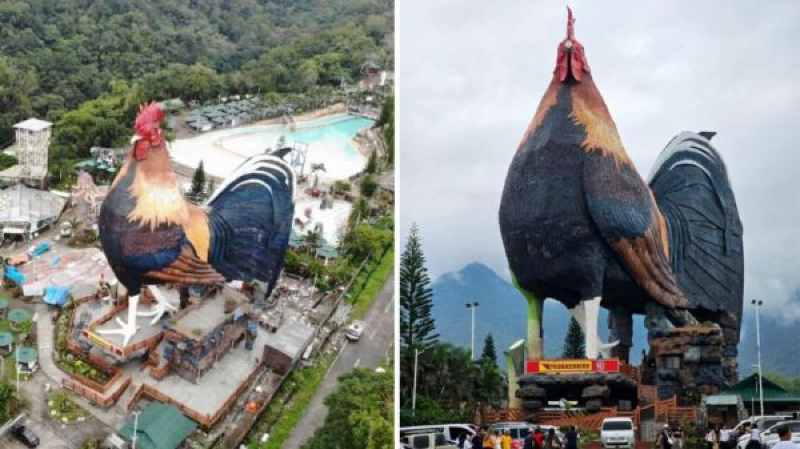Frank Lloyd Wright founded a bizarre sex commune

From The Independent: "Taliesin was an architectural commune set up in 1932 in Wisconsin by Wright and his wife, the mysterious Olgivanna. Staffed by young, eager, and mostly male architects who wanted to learn from the master, it quickly evolved into a place where Olgivanna, Wright’s third wife, could promote the teaching of Georgi Gurdjieff. This bald, mustached, charismatic Russian guru claimed his eyes could not only penetrate a man’s psyche, but also bring a woman to orgasm from across a room. Taliesin became a place where Wright would not only get free in-house labor, but his wife could have total sway over the mental, physical, and sexual lives of the architect’s devoted followers."
In Denmark an ancient army met a mysterious end

From Atlas Obscura: "In 1944, at the height of World War II, ditchdiggers working in a field known as Alken Enge, on the Jutland Peninsula in Denmark, made a gruesome discovery: human bones. It was quickly determined that the bones were not evidence of a recent murder—they were actually thousands of years old. About 2,000 years ago, during the Iron Age, the Alken Enge water-meadow had been a lake, but the individuals whose remains were scattered around the site had not died from drowning. Their deaths had been more horrific—and what happened to their bodies after death even more macabre. Many of the bones displayed the marks of raw violence: cuts from edged weapons, skulls crushed by axe blows, piercing wounds."
Thomas Edison's scientific insights may have come from his napping technique

From Scientific American: "Thomas Edison was famously opposed to sleeping. In an 1889 interview, the ever energetic inventor of the lightbulb claimed he never slept more than four hours a night. Yet Edison may have relied on slumber to spur his creativity. The inventor is said to have napped while holding a ball in each hand, presuming that, as he fell asleep, the orbs would fall to the floor and wake him. This way he could remember the sorts of thoughts that come to us as we are nodding off, which we often do not recall. Sleep researchers now suggest that Edison might have been on to something. A study reports that we have a brief period of creativity and insight in the semilucid state that occurs just as we begin to drift into sleep, a sleep phase called N1."
The first satellite built out of wood has made it to space

From Quartz: "A diminutive Japanese satellite called LignoSat arrived at the International Space Station on Tuesday to test that very question. The satellite is a small box with four-inch sides made of wood and will run tests on wood’s capabilities in space. LignoSat was created by researchers at Kyoto University along with a homebuilding company. Doi’s team has dreams of planting trees on Mars to use for homes. He thinks there could even be a future where metal satellites might even be banned. Kyoto University forest science professor Koji Murata noted to Reuters that early planes in the 1900s were made of wood. “A wooden satellite should be feasible, too,” Murata said, adding that wood would actually be more durable in space with the absence of oxygen and water."
This hotel is the largest building in the world shaped like a chicken

From UPI: "A hotel in the Philippines that stands 114 feet, 7 inches tall was awarded a Guinness World record for the largest building in the shape of a chicken. Campuestohan Highland Resort, located in Negros Occidental, unveiled its new rooster-shaped building, which features 15 air-conditioned hotel rooms. Ricardo Cano Gwapo Tan said he wanted the resort's new building to be an attention-grabber. "I had a vision to make something with a wow factor that can really leave a footprint of admiration to the public," he told Guinness World Records. "If you look at a rooster, it looks calm and commanding, imposing and strong which reflects the attitude of our people," he said.
High-speed boxing while blindfolded
Being able to do this blindfolded is crazy.. 🥊 😮💨 pic.twitter.com/XY5eo4ou1P
— Interesting As Fuck (@interesting_aIl) November 7, 2024
Acknowledgements: I find a lot of these links myself, but I also get some from other newsletters that I rely on as "serendipity engines," such as The Morning News from Rosecrans Baldwin and Andrew Womack, Jodi Ettenberg's Curious About Everything, Dan Lewis's Now I Know, Robert Cottrell and Caroline Crampton's The Browser, Clive Thompson's Linkfest, Noah Brier and Colin Nagy's Why Is This Interesting, Maria Popova's The Marginalian, Sheehan Quirke AKA The Cultural Tutor, the Smithsonian magazine, and JSTOR Daily. If you come across something interesting that you think should be included here, please feel free to email me at mathew @ mathewingram dot com



